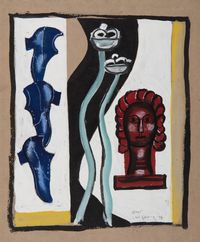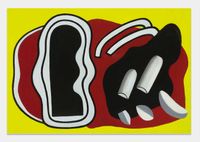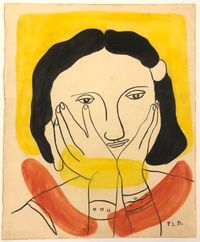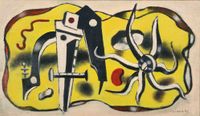Pioneering French artist Fernand Léger painted the fusion of man and machine that characterised modern life in the early 20th century. By integrating everyday imagery with bold compositions, Léger established his legacy as a forerunner to the Pop art movement.
Read MoreLéger was born in Argentan, a small rural town in Normandy, France. Little is known about his early life other than his peasant background, where he was expected to raise cattle like his father. However, Léger aspired to be an architect and trained as such from 1897 to 1899, before being apprenticed under an architect in Caen. He spent 1902 and 1903 in military service in Versailles, before applying and being rejected from the École des Beaux-Arts in Paris. Nevertheless, he took classes there as an unenrolled student for three years, while also studying at the Académie Julian.
Léger was an active teacher for many years, with a vast array of now-famous pupils. He was married twice, first to Jeanne-Augustine Lohy in 1919 and then to artist Nadia Khodossevitch in 1952.
Through combining modern industrial imagery with an innovative Cubist style, Fernand Léger demonstrated his keen interest in celebrating contemporary life.
Léger's earliest-known works reveal the dominant influences of Impressionism and Fauvism, but this would quickly shift to a Cubist approach, following exposure to Paul Cézanne's 1907 retrospective at the Salon d'Automne in Paris. Léger was enveloped in the Cubist movement through connections with poets Guillaume Apollinaire, Max Jacob, Blaise Cendrars, and Pierre Reverdy, adapting the Cubist splintering of forms to his own ends. He developed a style that was nicknamed 'tubism' by art critic Louis Vauxcelles. Nudes in the Forest (1910) demonstrates this variation, with the human body rendered in a grey jumble of cylinders and slabs, resembling a robot.
From 1914 to 1917, Léger was conscripted to military service, which influenced his following 'mechanical' period. His war experience, where in 1916 he was gassed and badly injured in Verdun, fuelled his focus on the human figure. Soldiers Playing Cards (1917) depicts hunched soldiers in a claustrophobic composition that mirrored the conditions of life in the trenches, albeit rendered here in schematic machine parts. Léger's renewed interest in taking 'subjects from our own epoch' married man and machine in painterly commentaries on the working class.
Three Women (1921—1922) is considered a masterpiece of Léger's post-war style. Three impassive female nudes repose in a chic apartment, their bodies sharply delineated in clusters of spheres and contoured forms. Segmented into shiny, gradated sections, their mechanistic body parts appear to be interchangeable with their setting. This work demonstrates Léger's faith in the integration of man and machine in the modern world. In 1924, Léger again evoked the intensity of the machine age for the Dadaist film Ballet Mécanique (Mechanical Ballet), collaborating with George Antheil, Dudley Murphy, and Man Ray. The film uses montage to quickly cut through shots of everyday consumer items, advertisements, and zoomed-in body parts.
The accessibility of Léger's visual language was a focus from the 1930s onwards, where lively and organic shapes would take centre stage. The lighter, more playful approach of his mature works is characterised in paintings like Landscape with Yellow Hat (1952), which depicts a still life-landscape fusion in flat colours and thick black outlines.
Composition (1953) overlaps flat abstract shapes also painted in primary colours. Léger credited his time in New York City as a major influence: 'I was struck by the neon advertisements flashing all over Broadway. You are there, you talk to someone, and all of a sudden he turns blue. Then the color fades—another one comes and turns him red or yellow.' In works like Divers, Blue and Black (1942—1943), Léger emphasised the plasticity of his figures, painting a group of swimming dockworkers in outlines overlapping a colourful jumble of blocks. In his later years, Léger would explore a wide range of varied projects, including book illustrations, large-scale murals, mosaics, set and costume design, and stained glass.
Fernand Léger works have been exhibited widely, both during and after his lifetime.
Rising to international prominence in the 1930s, Léger held a solo exhibition at the Museum of Modern Art (MoMA), New York titled Fernand Léger: Paintings and Drawings in 1935. He has also been the subject of several retrospective exhibitions, including at Tate Liverpool (2018); Centre Pompidou-Metz, Metz (2017); Philadelphia Museum of Art (2014); and MoMA, New York (1998). In 1960, a museum devoted to his work opened in Biot, Alpes-Maritimes, France.
Léger's work is held in major collection around the world, including MoMA, New York; the Art Institute of Chicago; Tate Gallery, London; Centre Pompidou, Paris; and the Albertina, Vienna.
Peter Derksen | Ocula | 2022










